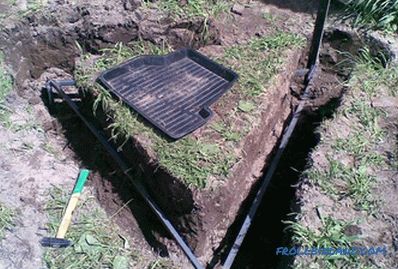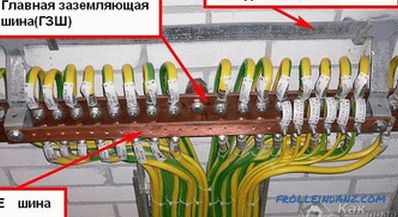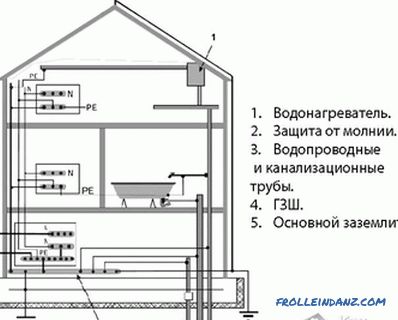By now, a whole set of special measures has been developed that provide reliable protection of the user against electrical shock in everyday life, which has made the process of operating electrical equipment safer.
The activities of this class should include the preparation of the ground, known to most owners of private housing called the "ground loop", which usually consists of the following structural elements:
- grounding device (ground) ;
- set of grounding conductors;
- special grounding bus.
In the article, we will talk about how to properly mount the grounding in a private house with your own hands, show the diagrams, photo and video instructions.
Selection and preparation of the grounding
 Grounding circuit
Grounding circuit
When organizing the grounding system in You can use one of the following metal structures of natural origin as a grounding conductor:
- any reinforced concrete piles buried in the ground;
- metal pipes or rails located on the ground surface;
- other metal elements of building structures buried in the ground.
In the event that nothing like this can be found near the house, you will have to prepare the earthing switch yourself.
To make this grounding element, you will need to prepare three steel electrodes with a length of 1.2 meters, which are subsequently welded together in such a way that a triangle of the correct shape is obtained as a result of these operations.
(When selecting segments of a steel pipe as electrodes, its diameter must be at least 30 millimeters).
 Circuit circuit In the case of using electrodes of a different profile, the cross-sectional area of the elements must be at least 150 mm 2 , and the length of the segments themselves - not less than 2 meters. Before placing such a structure into the ground, you should prepare a place for it in advance by digging three ditches half a meter deep (in the form of a triangle with sides approximately 1.2 meters long). Then, in the corners of the resulting figure with a small sledgehammer, you should hammer in three previously prepared ones and well pointed on one side of the electrode. To connect the hammered electrodes to each other, steel strips with a cross section of at least 50 mm 2 are used. All parts of the resulting structure at the joints are welded reliably (or articulated by means of bolted joints).
Circuit circuit In the case of using electrodes of a different profile, the cross-sectional area of the elements must be at least 150 mm 2 , and the length of the segments themselves - not less than 2 meters. Before placing such a structure into the ground, you should prepare a place for it in advance by digging three ditches half a meter deep (in the form of a triangle with sides approximately 1.2 meters long). Then, in the corners of the resulting figure with a small sledgehammer, you should hammer in three previously prepared ones and well pointed on one side of the electrode. To connect the hammered electrodes to each other, steel strips with a cross section of at least 50 mm 2 are used. All parts of the resulting structure at the joints are welded reliably (or articulated by means of bolted joints).
At the end of these procedures, you will need to forward the steel strip selected for the earthing switch to the point of the intended input of the grounding bus to the house (it is recommended to bring it closer to the switch cabinet and weld a small bolt on its end).
Next, using a copper wire with a cross section of 6mm 2 , passed through a hole in the wall and fixed on this bolt, you need to connect an ejected bus to the main ground bus (GZSH) located on the switchboard. From here protective grounding can be diluted in all areas of the home (as part of the working electrical wiring).
Ground bus arrangement
 Ground bus
Ground bus
To competently decide how to make the grounding correctly, you will have to perform the operation of the so-called "splitting" of the PEN-conductor, which is part of the cable from which your house is powered.
To obtain a separate ground bus, this wire must be divided into protective and working conductor (PE and N respectively)
Such splitting can be organized using the main ground bus already familiar to us.
This bus, in addition to the PEN conductor (winding up to the switchboard from the “vozdushki” line or from the underground cable), also supplies the previously designed grounding conductor connected by means of a bolted connection to the grounding bus.
 Grounding device
Grounding device
Thanks to this grounding (which is essentially repeated), you can artificially organize wiring separately zero bus and zero working conductor to all consumers directly from the main ground bus. In this case, the phase wire (L) is divorced with them.
Note that the OLCs include special requirements regarding the arrangement on the consumer side, the so-called re-grounding. They apply to sectoral industrial networks, the inclusion of loads in which is produced according to the scheme with a deaf-grounded neutral. This method of connection ensures the operability of the entire protective earthing system even in case of an emergency break of the PEN conductor.
It should be borne in mind that in urban apartments you will not succeed in splitting the PEN conductor due to re-grounding.
Video
A few words about mounting the grounding and grounding bus:




